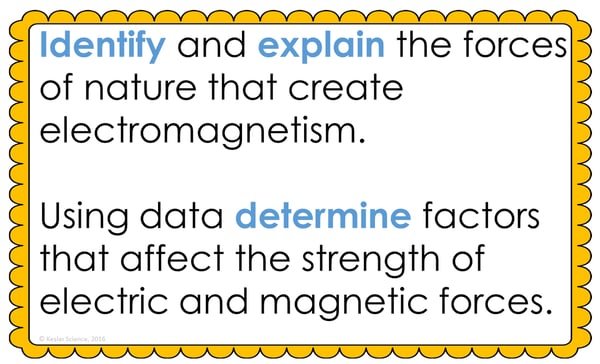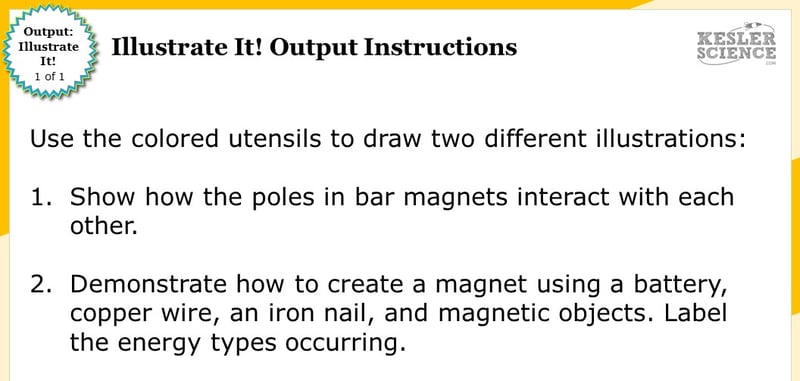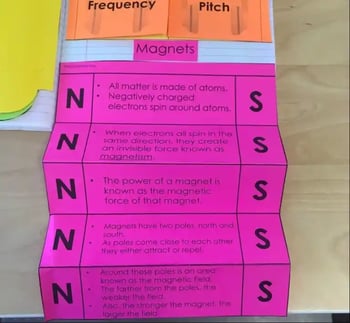Electric And Magnetic Forces Lesson Plan - A Complete Science Lesson Using the 5e Method of Instruction
By the end of this lesson about electric and magnetic forces, students will be able to identify and explain the natural forces that create electromagnetism. Students will learn to use data to determine what factors affect the strength of electric and magnetic forces. Each of our lessons is designed using the 5E method of instruction to ensure maximum comprehension by the students. This well-thought out unit does the heavy lifting, giving teachers easy-to-implement, highly engaging lesson plans.
This blog will walk you through each of the steps and activities of the Electric and Magnetic Forces 5E Lesson Plan.
ENGAGEMENT
Objective Introduction
At the beginning of the lesson, the class will do a Think-Pair-Share to discuss the objective.
Class Activity
- Tell the students they will be learning about magnetic and electrical forces.
- Ask students what they already know about magnets. Hopefully, they will include terms like: north and south poles, magnetic field, opposites attract and repel.
Student Activity
- Divide the class into groups depending on the number of magnets.
- Give each group a magnet, covering, and some iron filings.
- Have them place the magnet under the covering. (it’s extremely important not to touch the magnet directly to the iron filings)
- Ask them what they think will happen as they sprinkle the iron filings on top of and around the magnet. Where will most the iron filing fall?
- Carefully sprinkle the iron filings around the magnet and explain that they are seeing the usually invisible magnetic field. Ask them where the force is strongest. Notice how the filings stand up at poles showing the field is 3-dimensional.
- After doing the engagement, watch the video with the provided link.

The teacher will then help to clear up any misconceptions their students have about electric and magnetic forces. A common but major misconception, for example, is that students don’t realize the force field in 3-dimensional.
Estimated Class Time for the Engagement: 20-30 minutes
EXPLORATION
This student-centered station lab is set up so students can begin to explore electric and magnetic forces. With nine stations in total, you can introduce electromagnetic forces to your middle school students in a variety of ways! Four of these stations are considered input stations where students will learn new information about electric and magnetic forces, and four of the stations are output stations where students will be demonstrating their mastery of the lesson's material. A bonus station offers challenges for your early finishers and independent learners. You can read more about how I set up the station labs here.
Watch It!
At this station, students will be watching a short video explaining electric and magnetic forces. Students will then answer questions related to the video and record their answers on their lab station sheet. For example: What three minerals are attracted to a magnet? What is it about these minerals that make the Earth one big magnet? Where do these moving electrons come from when making an electromagnet? What is it that makes a magnet different from a piece of iron that is not magnetic?
Read It!
This station will provide students with a one-page reading about electric and magnetic forces. There are four follow-up questions that the students will answer to demonstrate their comprehension of the reading material.
Explore It!
Students will be working in pairs to better understand electric and magnetic forces. In this station, students interact with both electric and magnetic forces. Students will follow the steps and record their observations on their lab sheet.
Research It!
The research station will allow students to explore an interactive web page that helps them to understand electric and magnetic forces while playing a game. Students will be instructed to complete a few tasks and record answers on their lab sheets.
Organize It!
Students at this station will match the sets of cards. Cards are statements about electric and magnetic forces that students must decide whether they are true statements or false statements. Once students have completed their organization, the teacher will check their understanding.
Illustrate It!
Your visual students will love this station. Students are to draw pictures that demonstrate their knowledge of electric and magnetic forces.

Write It!
Students who can answer open-ended questions about the lab truly understand the concepts that are being taught. At this station, the students will be answering three task cards: Explain how two different bar magnets, with north and south poles, interact with each other? Explain the energy transformation process needed to create an electromagnet. How do coils impact the strength of the magnetic field?
Assess It!
The Assess It station is where students will go to prove mastery over the concepts they learned in the lab. The questions are set up in a standardized format with multiple choice answers. Some questions include: Describe the outcome when two magnets are placed with like poles near each other. Describe the outcome when two magnets with different poles are placed near each other. What is represented by the lines surrounding the magnet? Which best describes the energy transformation in this setup?
Challenge It! - Bonus Station
Early finishers and advanced students will love the extension activities in this station. Four activity choices offer them ways to expand their learning through mini-games and mini-projects.
Estimated Class Time for the Exploration: One or two 45-minute class periods
EXPLANATION
The explanation activities will become much more engaging for your class once they’ve completed the exploration station lab. During the explanation piece of the lesson, the teacher will be clearing up any misconceptions their students may have about electric and magnetic forces with a variety of materials. These materials include on-level and modified versions of the interactive presentation (may be used individually or projected), anchor charts, and paper or digital interactive notebook activities. If you have students that need modified notes, the 5E lessons come equipped to help give every student access to the lesson.

Interactive notebook samples: Above-left is a digital INB activity slide; above-right is an example of the paper INB activities.
The students will also be interacting with their journals while taking notes from the PowerPoint. If you have students that need modified notes, the 5E lessons come equipped to help give every student access to the lesson.
Estimated Class Time for the Exploration: Two or three 45-minute class periods
ELABORATION
The elaboration section of the 5E method of instruction gives students choices that allow them to prove they’ve mastered the concepts behind the lesson. When students are given a choice, they’re much more enthusiastic and invested in the project than they are when their teachers choose their projects for them. There are a total of nine choices to demonstrate understanding of electric and magnetic forces. A separate set of choices that offer more teacher support are also available for students that need them. Rubrics guide students to doing their best work and assist in grading.

Estimated Class Time for the Elaboration: Two or three 45-minute class periods (can also be used as an at-home project)
EVALUATION
The final piece of the 5E model is to evaluate your students' comprehension. Included in every 5E lesson is a homework assignment, assessment, and modified assessment. Research has shown that homework needs to be meaningful and applicable to real-world activities in order to be effective. When possible, I like to give open-ended assessments to truly gauge the student’s comprehension.
Estimated Class Time for the Elaboration: One 45-minute class period
DOWNLOAD THE FULL LESSON NOW
Download Over $100 in FREE Resources
For Middle School Science
Simply create a login below and gain immediate access to a selection of our Kesler Science product line worth $100 - for FREE. There's a full version of every product type! You'll also join tens of thousands of middle school science teachers who receive timely tips and strategies straight to their inbox.







